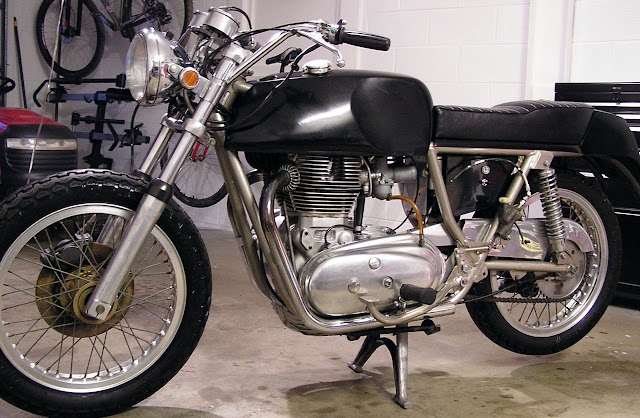Rickman Interceptor
Wide handlebars were a surprising feature of the racy Rickman, as were footrests on clamps around the exhaust pipes.
Handsome cafe- racer styling gave the Rickman a much more aggressive image than the standard Royal Enfield Interceptor that supplied its powerplant.
One of the most attractive and neatly engineered bikes of the early 1970s was the Rickman Interceptor, an improbable combination of 736cc Royal Enfield parallel twin engine and hand-built chassis from specialist firm Rickman. Although not particularly fast in a straight line, its light weight and agile handling confirmed that the old British parallel twin format still had plenty of potential.
The Rickman Interceptor owed its existence to the demise of Royal Enfield, the famous old marque that had gone out of business in 1969. One of the firm’s last enterprises had been to sell a batch of twin-cylinder engines (originally designed for the Royal Enfield Interceptor) to America, where they were to have powered bikes marketed as Indian Enfields. The British firm’s collapse meant that about 200 engines were left stranded at the docks.
Enter Rickman, the firm run by brothers Don and Derek Rickman, former motocross (scrambles) racers who had set up in business in Hampshire in the late 1950s. After starting by building off-road competition bikes using BSA frames, the Rickmans had begun constructing their own high-quality frames, and had then expanded to build roadgoing chassis too. In 1970 Rickman was commissioned by Royal Enfield’s US export agency, which had been left with the engines, to build a bike to use them up.
In typical Rickman style the Interceptor was a lean, light and beautifully crafted machine based around a twin-downtube frame of Reynolds 531 chrome-molybdenum steel tubing. The frame, a wider version of Rickman’s proven Metisse (‘mongrel bitch’ in French) design, was very rigid and finished in shiny nickel plate.
Cycle parts included Rickman’s own motocross-derived telescopic forks, whose 41mm diameter was considerably wider than those commonly used at the time, plus Borrani wheel rims and single disc brakes at front and rear. The Rickman was a good-looking bike, with a racy fuel tank and seat unit made from high quality fibreglass. By contrast its handlebars were high and wide, and its fairly forward-set footrests were clamped to the exhaust pipes in unusual fashion.
Engine development
The 736cc engine was Royal Enfield’s Series II Interceptor unit, the final development of a line of pushrod-operated parallel twins that dated back to the 692cc Meteor and Constellation of the 1950s. The Series II had been introduced in 1969, featuring wet- instead of dry-sump lubrication, and a more efficient oil pump. High-lift camshafts and a new ignition system helped give a peak output of either 52 or 56bhp (both figures were quoted) at 6750rpm.
That was enough to give both the standard Interceptor (which was produced mainly for export to America) and the Rickman a top speed of l I5mph (I85km/h). But it was the big twin’s acceleration at lower speeds that was most impressive, especially in the case of the Rickman, which at just 353lb (I60kg) was almost lOOlb (45kg) lighter than the Enfield model. From as low as 2000rpm in top gear, the twin surged forward with almost enough force to bend those wide bars.
The Rickman was also smooth by parallel twin standards. It was reasonably reliable too, thanks to the Series II motor’s improvements, although the four-speed gearbox was notably poor. Handling, roadholding and braking were excellent, though - good enough to give the lightweight Rickman the edge over most contemporary rivals when ridden hard on a twisty road.
That performance was not enough to keep the model in production after the initial batch of about 200 engines had been used up. But Rickman continued to thrive through the 1970s, building a series of fast and fine-handling CR (‘Cafe Racer’) specials around Japanese four-cylinder engines including Honda’s CB750 and Kawasaki’s Z900.
Specification Rickman Interceptor (1970)
- Engine Air-cooled ohv pushrod four-valve parallel twin
- Capacity 736cc (71 x 93mm)
- Maximum power 56bhp @ 6750rpm
- Transmission Four-speed, chain final drive
- Frame Steel twin cradle
- Suspension Telescopic front; twin shocks rear
- Brakes Disc front and rear
- Weight 353lb (160kg)
- Top speed 115mph (185km/h)


















0 comments: